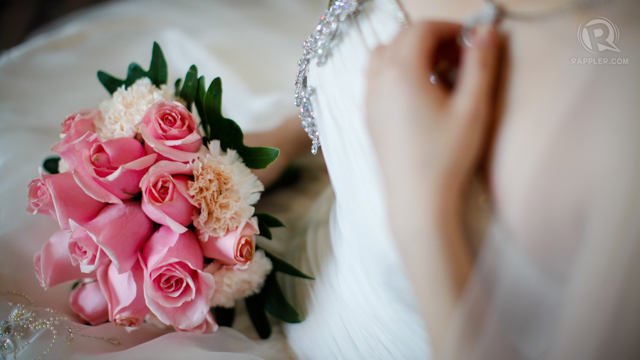SUMMARY
This is AI generated summarization, which may have errors. For context, always refer to the full article.

MANILA, Philippines – Despite being a predominantly Catholic country, there are fewer Filipinos who turned to the Catholic Church to solemnize their wedding rites.
Data released by the National Statistics Office (NSO) on Wednesday, March 27, showed that only 35.9% of weddings in the Philippines were solemnized in the Roman Catholic Church. More weddings, or around 42.5%, are done through civil rites.
In terms of actual numbers, the NSO said there were 202,614 civil marriages, higher than 171,046 civil weddings in 2011.
“Maybe because Church weddings usually come with elaborate celebrations. (You) need a full entourage for the different parts of the ceremony: the ring, coin, Bible, veil, cord, then principal sponsors,” National Economic and Development Authority (NEDA) OIC Assistant Director-General Rosemarie G. Edillon via SMS on Thursday, March 28.
NSO said marriages contracted through other religious rites including Muslim accounted for about 20.8%. There were 4,043 marriages solemnized through Muslim rites or around 0.8% while marriages celebrated through other religious rites reached 95,177 or 20% of all marriages in 2011.
Data also showed that there were 3,167 marriages solemnized under tribal rites or 0.7% of the total. There were also 361 or 0.1% of all marriages that were solemnized under ‘unstated’ ceremonies in 2011.
Continuous decline
The NSO data also showed that the total number of marriages in the Philippines continued to decline. In 2011, there were 476,408 marriages registered which was a 1.3% decline from the 482,480 registered marriages in 2010.
Data showed the biggest decrease in the number of recorded marriages was in Eastern Visayas (Region VIII) at 18.8% followed by Bicol and Caraga Regions with 9.2% and 7.9% decrease, respectively.
The number of marriages in the Autonomous Region of Muslim Mindanao (ARMM) increased by 79.7% compared with the previous year.
Most of these marriages occurred in May where a total of 55,529 weddings occurred. This accounted for 11.7% of all marriages in 2011.
In terms of daily average, February was the clear winner with as many as 1,799 per day. April managed to rank fifth in 2011, with a daily average of 1,496 marriages, despite ranking first in 2010.
August remained the least favored month for marriage as it accounted for only 24,763 marriages or a daily average of 799 weddings.
The NSO data also showed the median age for brides was 25.3 years old while 28 years old for grooms. This, NSO said, showed women prefer to marry at an earlier age than men.
The highest number of brides who got married was seen at age group 20 to 24 years old, while for grooms it was in age group 25 to 29 years old.
The NSO also said marriage involving teenage brides, around 58,320 or 12.2% of the total, was more than four times compared to those with teenage grooms. There were only 12,882 teenage grooms or 2.7% of the total.
There were also registered marriages with grooms 50 years and older. The number of men who settled down at age 50 and over reached 16,585 or 3.5% of the total and was more than twice that of women. There were around 7,012 or 1.5% of the total were women aged 50 and above. – with reports from Cai Ordinario/Rappler.com
Add a comment
How does this make you feel?
![[In This Economy] Is the Philippines quietly getting richer?](https://www.rappler.com/tachyon/2024/04/20240426-Philippines-quietly-getting-richer.jpg?resize=257%2C257&crop=194px%2C0px%2C720px%2C720px)
![[In This Economy] A counter-rejoinder in the economic charter change debate](https://www.rappler.com/tachyon/2024/04/TL-counter-rejoinder-apr-20-2024.jpg?resize=257%2C257&crop=267px%2C0px%2C720px%2C720px)
![[Vantage Point] Joey Salceda says 8% GDP growth attainable](https://www.rappler.com/tachyon/2024/04/tl-salceda-gdp-growth-04192024.jpg?resize=257%2C257&crop_strategy=attention)
![[ANALYSIS] A new advocacy in race to financial literacy](https://www.rappler.com/tachyon/2024/04/advocacy-race-financial-literacy-April-19-2024.jpg?resize=257%2C257&crop_strategy=attention)

There are no comments yet. Add your comment to start the conversation.